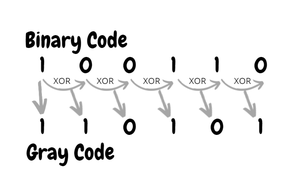[CSES] Gray Code
Gray Code
Task:
A Gray code is a list of all $2^n$ bit strings of length $n$, where any two successive strings differ in exactly
one bit (i.e., their Hamming distance is one).
Your task is to create a Gray code for a given length $n$.
Input
The only input line has an integer $n$.
Output
Print $2^n$ lines that describe the Gray code. You can print any valid solution.
Constraints
- $1 \le n \le 16$
Input:
2Output:
00
01
11
10
Solutions:
Intuition:If you write down the sequence of Gray Code from $n=1$ to $n=3$, I think it can help to give an intuition about its pattern.
- $n=1: 0 \; 1$
- $n=2: 00 \; 01 \; 11 \; 10$
- $n=3: 000 \; 001 \; 011 \; 010 \; 110 \; 111 \; 101 \; 100$
1def grayCode(n: int):
2 prev = ["0","1"]
3 for i in range(1,n):
4 fir_half=["0"+i for i in prev]
5 sec_half=["1"+i for i in prev[::-1]]
6 prev=fir_half+sec_half
7 for i in prev:
8 print(i)
9
10n=int(input())
11grayCode(n)
12 Time complexity: O(N).
Space complexity: O(N).
It appears that Gray code can be solve with less runtime as well as memory usage. Based on an orderly formula, we can convert consecutive Binary code to valid Gray code sequence.
- The MSB of Gray Code is always equivalent to the respective Binary.
- The next bit in Gray Code can be formed by doing XOR the bit of current index with previous index bit in Binary code.
 Because It's the XOR operation with 2 successive bits, shifting is a good choice for lean implementation. In order to hold the same MSB, right shift should be chosen.
Because It's the XOR operation with 2 successive bits, shifting is a good choice for lean implementation. In order to hold the same MSB, right shift should be chosen.
For ex:
The 11th Gray code number is achieved by doing a transformation from Binary 11 to Graycode.
- 11 in Binary: 1011
- Right shift: $1011>>1 = 0101$
- XOR: $1011 \oplus 0101$ = 1110
11th GrayCode number is $1110$
Implementation:1 import math
2 def g(n):
3 return n^(n>>1)
4 def grayCode(n):
5 for i in range(2**n):
6 res=bin(g(i))[2:]
7 print((n-len(res))*"0"+res)
8 grayCode(int(input()))
9 Analysis:
Time complexity: O(N).
Space complexity: O(1).